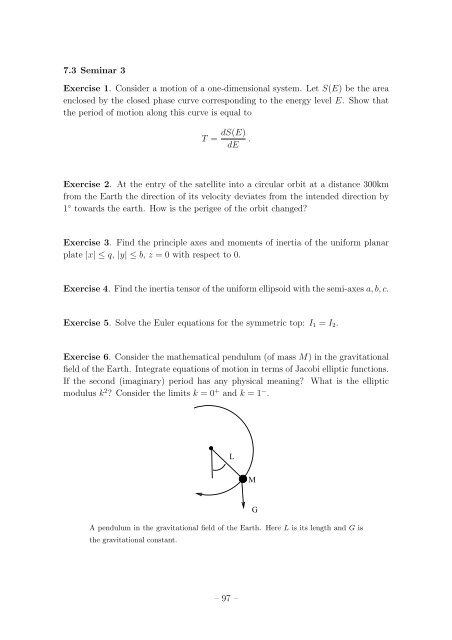Student Seminar: Classical and Quantum Integrable Systems
Student Seminar: Classical and Quantum Integrable Systems
Student Seminar: Classical and Quantum Integrable Systems
Create successful ePaper yourself
Turn your PDF publications into a flip-book with our unique Google optimized e-Paper software.
7.3 <strong>Seminar</strong> 3<br />
Exercise 1. Consider a motion of a one-dimensional system. Let S(E) be the area<br />
enclosed by the closed phase curve corresponding to the energy level E. Show that<br />
the period of motion along this curve is equal to<br />
T = dS(E)<br />
dE .<br />
Exercise 2. At the entry of the satellite into a circular orbit at a distance 300km<br />
from the Earth the direction of its velocity deviates from the intended direction by<br />
1 ◦ towards the earth. How is the perigee of the orbit changed?<br />
Exercise 3. Find the principle axes <strong>and</strong> moments of inertia of the uniform planar<br />
plate |x| ≤ q, |y| ≤ b, z = 0 with respect to 0.<br />
Exercise 4. Find the inertia tensor of the uniform ellipsoid with the semi-axes a, b, c.<br />
Exercise 5. Solve the Euler equations for the symmetric top: I 1 = I 2 .<br />
Exercise 6. Consider the mathematical pendulum (of mass M) in the gravitational<br />
field of the Earth. Integrate equations of motion in terms of Jacobi elliptic functions.<br />
If the second (imaginary) period has any physical meaning? What is the elliptic<br />
modulus k 2 ? Consider the limits k = 0 + <strong>and</strong> k = 1 − .<br />
L<br />
01<br />
01<br />
M<br />
A pendulum in the gravitational field of the Earth. Here L is its length <strong>and</strong> G is<br />
the gravitational constant.<br />
G<br />
– 97 –

















